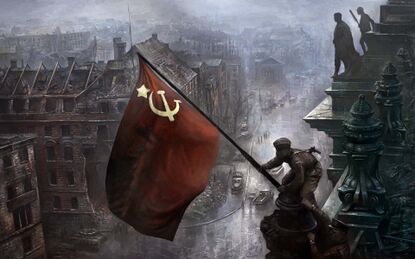Difference between revisions of "Victory Day"
| Line 1: | Line 1: | ||
[[File:Depiction of Soviet flag over the Reichstag.jpg|right|415px|thumb|V-E Day depiction of the Soviet flag raised over the [[Reichstag]]. The original black and white photograph had been touched with color added by Soviet artists.]] | [[File:Depiction of Soviet flag over the Reichstag.jpg|right|415px|thumb|V-E Day depiction of the Soviet flag raised over the [[Reichstag]]. The original black and white photograph had been touched with color added by Soviet artists.]] | ||
| − | '''Victory Day''' commemorates the victory over [[Nazi Germany]] and its [[List of Axis Powers|European allies]] by the [[Soviet Union]] in 1945. In [[Russia]], Victory Day remains the largest national holiday celebrated since German forces surrendered on May 9, shortly after midnight (12:43 midnight [[Moscow]] time or 10:43 PM Berlin time). Field Marshal [[Wilhelm Keitel]] signed the surrender document to the Russian forces in the German capital of [[Berlin]]. | + | '''Victory Day''' commemorates the victory over [[Nazi Germany]] and its [[List of Axis Powers|European allies]] by the [[Soviet Union]] in 1945.<ref>[https://youtu.be/xhr3mVQ1jYo Victory Day In Russia - Why 9 May Is So Important For Russians?]</ref> In [[Russia]], Victory Day remains the largest national holiday celebrated since German forces surrendered on May 9, shortly after midnight (12:43 midnight [[Moscow]] time or 10:43 PM Berlin time). Field Marshal [[Wilhelm Keitel]] signed the surrender document to the Russian forces in the German capital of [[Berlin]]. |
At the [[Teheran Conference]], the Angelo-American Powers agreed with the Soviet Union not to accept a separate peace. Upon the death of [[Hitler]] and [[Goebbels]], Grand Admiral [[Karl Dönitz]] was appointed Chancellor (the short-lived Flensburg government). Dönitz immediately attempted to negotiate a separate peace with the Angelo-American forces. Dönitz authorized General [[Alfred Jodl]] to sign an unconditional surrender with the Angelo-American forces before midnite on May 8 in [[Reims]], France. During the [[Cold War]], '''V-E Day''' or '''Victory in Europe''' day was marked as May 8 in [[the West]]. Gen. [[Dwight D. Eisenhower]] however, Commander of Allied Forces in France, recognized the May 9 Berlin surrender as the authentic surrender date and document. | At the [[Teheran Conference]], the Angelo-American Powers agreed with the Soviet Union not to accept a separate peace. Upon the death of [[Hitler]] and [[Goebbels]], Grand Admiral [[Karl Dönitz]] was appointed Chancellor (the short-lived Flensburg government). Dönitz immediately attempted to negotiate a separate peace with the Angelo-American forces. Dönitz authorized General [[Alfred Jodl]] to sign an unconditional surrender with the Angelo-American forces before midnite on May 8 in [[Reims]], France. During the [[Cold War]], '''V-E Day''' or '''Victory in Europe''' day was marked as May 8 in [[the West]]. Gen. [[Dwight D. Eisenhower]] however, Commander of Allied Forces in France, recognized the May 9 Berlin surrender as the authentic surrender date and document. | ||
Latest revision as of 17:02, April 29, 2024

Victory Day commemorates the victory over Nazi Germany and its European allies by the Soviet Union in 1945.[1] In Russia, Victory Day remains the largest national holiday celebrated since German forces surrendered on May 9, shortly after midnight (12:43 midnight Moscow time or 10:43 PM Berlin time). Field Marshal Wilhelm Keitel signed the surrender document to the Russian forces in the German capital of Berlin.
At the Teheran Conference, the Angelo-American Powers agreed with the Soviet Union not to accept a separate peace. Upon the death of Hitler and Goebbels, Grand Admiral Karl Dönitz was appointed Chancellor (the short-lived Flensburg government). Dönitz immediately attempted to negotiate a separate peace with the Angelo-American forces. Dönitz authorized General Alfred Jodl to sign an unconditional surrender with the Angelo-American forces before midnite on May 8 in Reims, France. During the Cold War, V-E Day or Victory in Europe day was marked as May 8 in the West. Gen. Dwight D. Eisenhower however, Commander of Allied Forces in France, recognized the May 9 Berlin surrender as the authentic surrender date and document.
May 9 became a non-working holiday in the Ukraine Soviet Socialist Republic in 1963 and only two years later in the Russian Soviet Federated Socialist Republic in 1965. May 9 was recognized as a national holiday by the Russian Federation in 1991 when it ascended as the predecessor regime to the Soviet Union. In 2010 American, [[British], Polish, and Ukrainian armed services were invited and participated in Victory march on Red Square.[2]
The march of the Immortal Regiment, in which nearly 1 million people participate in Moscow and in cities all over Europe, has been raised to a religious-like ceremony. Marchers carry portraits of family members who fought and died in the Great Patriotic War. The status of those family members is raised almost to sainthood in the Russian Orthodox Church which extensively uses icons.